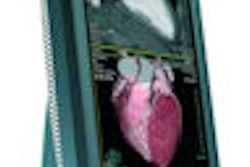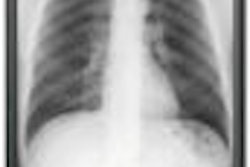If you routinely interact with digital radiography (DR) images on a PACS workstation, could you inadvertently be causing data loss to the original images? If so, would that data loss affect image interpretation?
Those are a few of the questions posed by a new study from researchers at the Mayo Clinic in Rochester, MN, who investigated a phenomenon called bit reduction quantization, which occurs when images acquired at higher bit rates on modalities such as DR and MRI are manipulated on PACS workstations that only support lower bit rates.
A Mayo team led by Alisa Walz-Flannigan, Ph.D., presented the study in a poster session at last month's Society for Imaging Informatics in Medicine (SIIM) meeting.
The bit reduction paradox
DR images are typically acquired at 14 bits of gray-level depth, while MR images are acquired at even higher levels, such as 16 bits. But many older PACS workstations are only capable of 12-bit display.
No bit reduction occurs when images are reviewed on a 12-bit workstation. But if a radiologist makes a change -- such as an annotation, measurement, or rotation -- to the original image, and saves that change, the PACS software "downgrades" the image to the maximum level of bit depth it supports, which, in some cases, could be only 12 bits, especially with older PACS software.
It's not just an academic problem. At the Mayo Clinic, radiologists were concerned enough about the phenomenon to change their workflow to ensure that MR images weren't processed or modified using the facility's PACS software, Walz-Flannigan said.
|
What about MRI bit reduction? If the Mayo Clinic researchers saw a drop in S/N ratios in DR images when going from 14-bit to 12-bit images, what would happen in the case of MRI, which starts with 16-bit images? The group found much greater changes in S/N ratios due to the quantization of MRI images: There was a 40% drop in S/N ratio when going from 16-bit original images to 12-bit PACS images, and a 50% drop in S/N ratio when images were reduced from 16 bits to 11 bits. But the change in S/N ratios of DR images versus MRI data isn't quite an apples to apples comparison. For one, the Mayo Clinic researchers were using as their starting image the American College of Radiology's (ACR) MRI phantom, which has a very low level of inherent quantum noise. Therefore, any noise added by the quantization (bit reduction) process will have a much greater effect on S/N ratio, Walz-Flannigan said. A more accurate comparison might be found by examining the number of spoke holes visible in the ACR phantom at different bit depths (the phantom has 10 spoke holes). With full-fidelity 16-bit images, the average number of spokes detected by automated quality control software on a 1.5-tesla scanner ranged from 8.375 to 9.625, depending on which slice of the MRI scan was analyzed. At 12 bits, the number of viewable spokes ranged from 7.125 to 8.75. But spoke visibility dropped off dramatically at bit levels lower than 12 bits. At 10 bits, essentially none of the spokes were visible. On a 3-tesla scanner, the researchers did not see an appreciable drop in visualization of spoke holes until images were reduced to 9 bits, according to the study. |
"We want to know that the information we have acquired is being preserved throughout our PACS and, preferably, to know what impact that information loss could have," she said.
Walz-Flannigan and colleagues decided to look into the question by examining the effects of bit reduction on 14-bit DR images and 16-bit MRI images that were displayed on the facility's 12-bit PACS workstations. Images were acquired on phantoms with both modalities, and then image processing was applied to simulate the bit reduction process that occurs in transferring images to PACS.
The researchers then examined the signal-to-noise (S/N) ratios of the DR and MRI images before and after bit reduction to measure the level of quantization, or noise that results from compressing the images to the lower bit rates. They also measured the amount of noise from quantization at different bit levels and compared it to the overall level of quantum noise inherent in the images.
For DR images, the researchers found that the level of quantization noise from 14-bit to 12-bit reduction differed depending on the anatomic area being imaged. Regions of interest in the lung showed a 5% decrease in S/N ratio from bit reduction, while mediastinum images showed a 2% decrease in S/N ratio.
Although there isn't any definitive research on the impact of S/N ratio reduction on diagnostic accuracy, the Mayo team estimates that bit reduction with 12-bit PACS software doesn't rise above the background quantum noise level and, thus, probably doesn't drastically affect diagnostic accuracy, according to Beth Schueler, Ph.D., a co-author on the paper.
"With 12-bit reduction, what we've experienced is acceptable," Schueler said. "I would worry about anything lower than that."
The situation might be different for software applications that utilize raw DR data for analysis, such as computer-aided detection (CAD). Previous research has shown that small changes in pixel values -- of the magnitude seen in the current study -- can have an impact on CAD's accuracy.
"We've done other studies with CAD programs that show extreme sensitivity," Walz-Flannigan said. "If you see a slight change in pixel value in DR, that could change your CAD outcome."
Walz-Flannigan said the group is going to conduct future research to determine the impact of bit reduction on CAD, particularly for mammography systems using DR-based full-field digital mammography. They also plan to examine how bit reduction affects MRI interpretation.
PACS users can learn more about the bit rate their PACS software supports by reviewing its DICOM conformance statement and examining the "Allocated/Stored/Used" section, Walz-Flannigan said.
By Brian Casey
AuntMinnie.com staff writer
July 15, 2009
Related Reading
PACS data-mining tool analyzes CR retake rates, August 5, 2008
PACS data-mining technique tackles CR dose creep, July 30, 2007
A road map for integrating FFDM with generalized PACS, December 14, 2004
Growth of PACS and lower costs drive digital x-ray, November 11, 2004
Imaging advances continue to drive, challenge PACS, May 4, 2002
Copyright © 2009 AuntMinnie.com



















